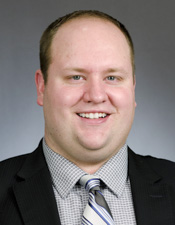Improvements proposed to 2015 nursing facility payment reforms
When employees at Park River Estates Care Center in Coon Rapids were told they would be getting raises, some cried. Others thought the facility administrator was joking.
The changes meant one employee didn’t have to choose between paying rent and replacing their tires, another could finally afford to marry their fiancé and a third wouldn’t have to go to the food shelf to make ends meet, administrator Tom Pollock said.
The nursing facility was able to afford the increases because of 2015 reforms that set a new formula for determining how nursing homes were reimbursed for services provided to eligible elderly and disabled people, he told the House Subcommittee on Aging and Long-Term Care Wednesday.
“(When) you have stable employees, the residents are happier and the families are happier,” Pollock said.
But the work isn’t complete, Rep. Joe Schomacker (R-Luverne) said as he introduced a bill intended to clarify and improve the 2015 reforms. Approved as amended by the subcommittee, HF500 was referred to the House Health and Human Services Reform Committee. There is no Senate companion.
Since the original bill was implemented, “We learned a few things … we didn’t consider ahead of time,” Schomacker said. “We just want … to make sure that we have a bill that will, indeed, continue to be something that will be useful for us now and into the future.”
Clarifications and additions made by HF500 include provisions that would:
- allow tuition reimbursement for any registered nurses and licensed practical nurses, not just those who are newly graduated or recently hired;
- permit nursing homes to take on bad debt under certain circumstances, like when a patient cannot afford their own care, but is waiting to be approved by Medicaid;
- limit rate changes to go into effect on Jan. 1 and July 1 of each year, which would ease the administrative burden that comes with new rates coming out monthly; and
- require the commissioner to provide the Legislature with a biennial report that addresses the impact of the adjusted limits, including employee retention rates and whether rate increases are being passed through to employees.
Related Articles
Search Session Daily
Advanced Search OptionsPriority Dailies
Ways and Means Committee OKs proposed $512 million supplemental budget on party-line vote
By Mike Cook Meeting more needs or fiscal irresponsibility is one way to sum up the differences among the two parties on a supplemental spending package a year after a $72 billion state budg...
Meeting more needs or fiscal irresponsibility is one way to sum up the differences among the two parties on a supplemental spending package a year after a $72 billion state budg...
Minnesota’s projected budget surplus balloons to $3.7 billion, but fiscal pressure still looms
By Rob Hubbard Just as Minnesota has experienced a warmer winter than usual, so has the state’s budget outlook warmed over the past few months.
On Thursday, Minnesota Management and Budget...
Just as Minnesota has experienced a warmer winter than usual, so has the state’s budget outlook warmed over the past few months.
On Thursday, Minnesota Management and Budget...
